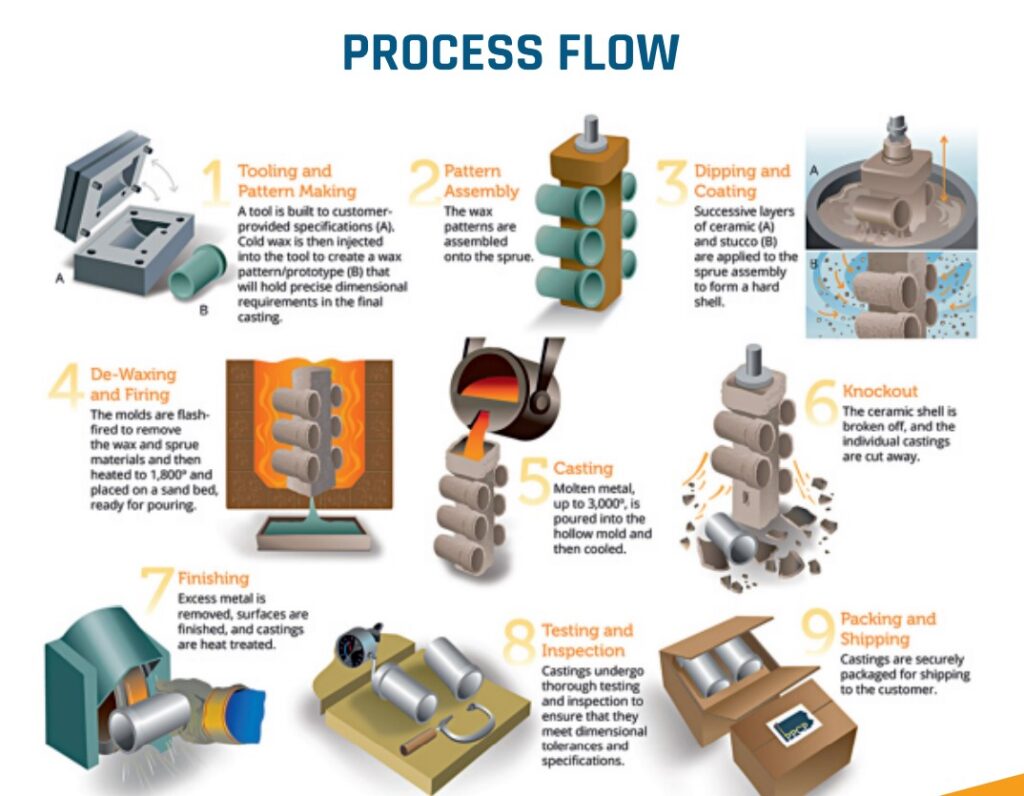FAQ's
Investment Casting Process FAQs
Creating a multi-part or single-part mold to accept molten metal by forming ceramic around wax patterns is investment casting. It is also known as lost wax casting or precision casting. This procedure employs an expendable injection molded wax pattern process To generate complicated structures with superior surface quality. A wax pattern, or cluster of them, is dipped into ceramic material numerous times to produce a thick shell to create a mold.
After that, they dry the shell and create the ceramic one without wax. Pour Melted metal into the ceramic shell cavities or clusters.
Tear off the ceramic shell to show the completed cast metal item once solidified and cooled. Precision investment castings in varied materials may achieve outstanding precision for small and large casting parts.

- The surface finish is excellent and smooth.
- Dimensional tolerances are tight.
- With design flexibility, intricate and complex shapes are possible.
- The casting component becomes lighter because of the thin walls cast.
- There are varied cast metals ranges, and alloys are available (ferrous and non-ferrous).
- In the mold design, the draft is not necessary.
- It minimizes the need for further machining.
- Low waste of materials.
During investment casting, a wax design is covered with a ceramic substance. When that thing gets solidified, it adopts the interior geometry of the intended casting.
The individual wax designs are usually attached to a central wax stick called a sprue for maximum efficiency in casting many pieces.
Melt the wax out of the design (thus the name “lost wax”), and pour the molten metal into the hollow. After the metal has solidified, shake off the ceramic mold, leaving the required casting in a near-net form, which is then finished, tested, and packaged.
The investment castings are often more expensive than forged components or sand or permanent mold casting processes. It is because of mold expenses and labor. However, they compensate for the additional cost by reducing machining time.
They do this by casting to near-net form tolerances. For example, innovations in vehicle rocker arms have been cast with almost no machining required.
Many items that require finishing, such as turning, milling, grinding, and drilling, may be investment cast using only 0.020-0.030 finish stock.
In addition, investment castings require minimum draft angles to remove patterns from tooling, and no draft is needed to extract metal castings from the investment shell. It allows for the creation of castings with 90-degree angles without further machining.
Our foundry offers various casting manufacturing services as one of the most well-known steel casting manufacturers. Currently, our monthly capacity ranges from 150 to 180 tons.
We can make a wide range of cast items for several industries and applications. We can cast any material composition per customer specifications, fulfilling GHOST, EN, JIS, DIN, ASTM, UNI, and other standards. The following are our casting stats:
The maximum weight that our foundry can cast is 120 kg
The maximum size that our foundry can cast is 26 inches (660mm)
We pour over 150 different alloys at Siddhalaxmi, making us one of the industry’s most diverse investment casting alloy options. You can find all types of air-melted Martensitic, Austenitic, Ferritic, and duplex stainless steels such as CF 8, CF 8M, CF 3M, CD 4MCU, CN 7M, 17-4 PH, 17-7 PH, CA-15, low and high alloy steels, plain carbon steels, and cobalt-based alloys, at our foundry. We also provide Ductile Iron, Copper & Alloys, Aluminum & Alloys, and more per international standards such as AISI, ASTM, MIL, SAE, BS, IS, JIS, DIN, SS, and others.
The choice between ferrous and non-ferrous casting alloys depends on the application type. Ferrous metals contain iron and are therefore more susceptible to corrosion, making them less suitable for applications where parts will be exposed to moisture and other environmental elements. Their magnetic properties, however, make them valuable for many electrical applications and their tensile strength makes them suitable for heavy duty applications. Ferrous metals include iron and iron alloys such as steel. Stainless steel is another ferrous alloy that is highly durable and magnetic, but it also has corrosion-resistant properties due to its chromium content.
Non-ferrous casting alloys are more malleable than ferrous alloys and provide high resistance to corrosion. They are also more lightweight than their ferrous counterparts and can have magnetic properties. Common non-ferrous alloys include aluminium, copper and copper alloys, and nickel.
Investment casting is performed using a wide range on ferrous and non-ferrous alloys, each delivering different advantages such as cost, strength, and temperature or corrosion resistance. We work with over 74 different air melted casting alloys to provide you with the perfect solution for your precision investment casting requirements.
